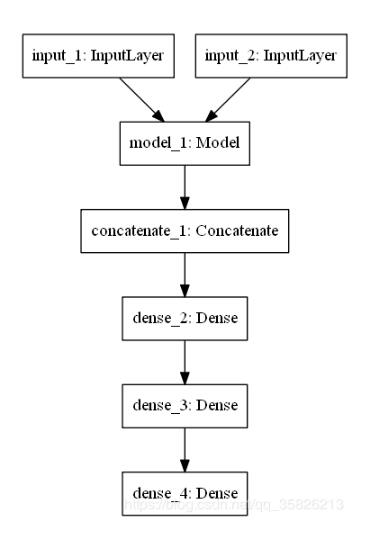首先声明,这里的权值共享指的不是CNN原理中的共享权值,而是如何在构建类似于Siamese Network这样的多分支网络,且分支结构相同时,如何使用keras使分支的权重共享。
Functional API
为达到上述的目的,建议使用keras中的Functional API,当然Sequential 类型的模型也可以使用,本篇博客将主要以Functional API为例讲述。
keras的多分支权值共享功能实现,官方文档介绍
上面是官方的链接,本篇博客也是基于上述官方文档,实现的此功能。(插一句,keras虽然有中文文档,但中文文档已停更,且中文文档某些函数介绍不全,建议直接看英文官方文档)
不共享参数的模型
以MatchNet网络结构为例子,为方便显示,将卷积模块个数减为2个。首先是展示不共享参数的模型,以便观看完整的网络结构。
整体的网络结构如下所示:
代码包含两部分,第一部分定义了两个函数,FeatureNetwork()生成特征提取网络,ClassiFilerNet()生成决策网络或称度量网络。网络结构的可视化在博客末尾。在ClassiFilerNet()函数中,可以看到调用了两次FeatureNetwork()函数,keras.models.Model也被使用的两次,因此生成的input1和input2是两个完全独立的模型分支,参数是不共享的。
from keras.models import Sequential
from keras.layers import merge, Conv2D, MaxPool2D, Activation, Dense, concatenate, Flatten
from keras.layers import Input
from keras.models import Model
from keras.utils import np_utils
import tensorflow as tf
import keras
from keras.datasets import mnist
import numpy as np
from keras.utils import np_utils
from keras.callbacks import EarlyStopping, ModelCheckpoint, TensorBoard, ReduceLROnPlateau
from keras.utils.vis_utils import plot_model
# ---------------------函数功能区-------------------------
def FeatureNetwork():
"""生成特征提取网络"""
"""这是根据,MNIST数据调整的网络结构,下面注释掉的部分是,原始的Matchnet网络中feature network结构"""
inp = Input(shape = (28, 28, 1), name='FeatureNet_ImageInput')
models = Conv2D(filters=24, kernel_size=(3, 3), strides=1, padding='same')(inp)
models = Activation('relu')(models)
models = MaxPool2D(pool_size=(3, 3))(models)
models = Conv2D(filters=64, kernel_size=(3, 3), strides=1, padding='same')(models)
# models = MaxPool2D(pool_size=(3, 3), strides=(2, 2))(models)
models = Activation('relu')(models)
models = Conv2D(filters=96, kernel_size=(3, 3), strides=1, padding='valid')(models)
models = Activation('relu')(models)
models = Conv2D(filters=96, kernel_size=(3, 3), strides=1, padding='valid')(models)
models = Activation('relu')(models)
models = Flatten()(models)
models = Dense(512)(models)
models = Activation('relu')(models)
model = Model(inputs=inp, outputs=models)
return model
def ClassiFilerNet(): # add classifier Net
"""生成度量网络和决策网络,其实maychnet是两个网络结构,一个是特征提取层(孪生),一个度量层+匹配层(统称为决策层)"""
input1 = FeatureNetwork() # 孪生网络中的一个特征提取
input2 = FeatureNetwork() # 孪生网络中的另一个特征提取
for layer in input2.layers: # 这个for循环一定要加,否则网络重名会出错。
layer.name = layer.name + str("_2")
inp1 = input1.input
inp2 = input2.input
merge_layers = concatenate([input1.output, input2.output]) # 进行融合,使用的是默认的sum,即简单的相加
fc1 = Dense(1024, activation='relu')(merge_layers)
fc2 = Dense(1024, activation='relu')(fc1)
fc3 = Dense(2, activation='softmax')(fc2)
class_models = Model(inputs=[inp1, inp2], outputs=[fc3])
return class_models
# ---------------------主调区-------------------------
matchnet = ClassiFilerNet()
matchnet.summary() # 打印网络结构
plot_model(matchnet, to_file='G:/csdn攻略/picture/model.png') # 网络结构输出成png图片
共享参数的模型
FeatureNetwork()的功能和上面的功能相同,为方便选择,在ClassiFilerNet()函数中加入了判断是否使用共享参数模型功能,令reuse=True,便使用的是共享参数的模型。
关键地方就在,只使用的一次Model,也就是说只创建了一次模型,虽然输入了两个输入,但其实使用的是同一个模型,因此权重共享的。
from keras.models import Sequential
from keras.layers import merge, Conv2D, MaxPool2D, Activation, Dense, concatenate, Flatten
from keras.layers import Input
from keras.models import Model
from keras.utils import np_utils
import tensorflow as tf
import keras
from keras.datasets import mnist
import numpy as np
from keras.utils import np_utils
from keras.callbacks import EarlyStopping, ModelCheckpoint, TensorBoard, ReduceLROnPlateau
from keras.utils.vis_utils import plot_model
# ----------------函数功能区-----------------------
def FeatureNetwork():
"""生成特征提取网络"""
"""这是根据,MNIST数据调整的网络结构,下面注释掉的部分是,原始的Matchnet网络中feature network结构"""
inp = Input(shape = (28, 28, 1), name='FeatureNet_ImageInput')
models = Conv2D(filters=24, kernel_size=(3, 3), strides=1, padding='same')(inp)
models = Activation('relu')(models)
models = MaxPool2D(pool_size=(3, 3))(models)
models = Conv2D(filters=64, kernel_size=(3, 3), strides=1, padding='same')(models)
# models = MaxPool2D(pool_size=(3, 3), strides=(2, 2))(models)
models = Activation('relu')(models)
models = Conv2D(filters=96, kernel_size=(3, 3), strides=1, padding='valid')(models)
models = Activation('relu')(models)
models = Conv2D(filters=96, kernel_size=(3, 3), strides=1, padding='valid')(models)
models = Activation('relu')(models)
# models = Conv2D(64, kernel_size=(3, 3), strides=2, padding='valid')(models)
# models = Activation('relu')(models)
# models = MaxPool2D(pool_size=(3, 3), strides=(2, 2))(models)
models = Flatten()(models)
models = Dense(512)(models)
models = Activation('relu')(models)
model = Model(inputs=inp, outputs=models)
return model
def ClassiFilerNet(reuse=False): # add classifier Net
"""生成度量网络和决策网络,其实maychnet是两个网络结构,一个是特征提取层(孪生),一个度量层+匹配层(统称为决策层)"""
if reuse:
inp = Input(shape=(28, 28, 1), name='FeatureNet_ImageInput')
models = Conv2D(filters=24, kernel_size=(3, 3), strides=1, padding='same')(inp)
models = Activation('relu')(models)
models = MaxPool2D(pool_size=(3, 3))(models)
models = Conv2D(filters=64, kernel_size=(3, 3), strides=1, padding='same')(models)
# models = MaxPool2D(pool_size=(3, 3), strides=(2, 2))(models)
models = Activation('relu')(models)
models = Conv2D(filters=96, kernel_size=(3, 3), strides=1, padding='valid')(models)
models = Activation('relu')(models)
models = Conv2D(filters=96, kernel_size=(3, 3), strides=1, padding='valid')(models)
models = Activation('relu')(models)
# models = Conv2D(64, kernel_size=(3, 3), strides=2, padding='valid')(models)
# models = Activation('relu')(models)
# models = MaxPool2D(pool_size=(3, 3), strides=(2, 2))(models)
models = Flatten()(models)
models = Dense(512)(models)
models = Activation('relu')(models)
model = Model(inputs=inp, outputs=models)
inp1 = Input(shape=(28, 28, 1)) # 创建输入
inp2 = Input(shape=(28, 28, 1)) # 创建输入2
model_1 = model(inp1) # 孪生网络中的一个特征提取分支
model_2 = model(inp2) # 孪生网络中的另一个特征提取分支
merge_layers = concatenate([model_1, model_2]) # 进行融合,使用的是默认的sum,即简单的相加
else:
input1 = FeatureNetwork() # 孪生网络中的一个特征提取
input2 = FeatureNetwork() # 孪生网络中的另一个特征提取
for layer in input2.layers: # 这个for循环一定要加,否则网络重名会出错。
layer.name = layer.name + str("_2")
inp1 = input1.input
inp2 = input2.input
merge_layers = concatenate([input1.output, input2.output]) # 进行融合,使用的是默认的sum,即简单的相加
fc1 = Dense(1024, activation='relu')(merge_layers)
fc2 = Dense(1024, activation='relu')(fc1)
fc3 = Dense(2, activation='softmax')(fc2)
class_models = Model(inputs=[inp1, inp2], outputs=[fc3])
return class_models
如何看是否真的是权值共享呢?直接对比特征提取部分的网络参数个数!
不共享参数模型的参数数量:

共享参数模型的参数总量

共享参数模型中的特征提取部分的参数量为:

由于截图限制,不共享参数模型的特征提取网络参数数量不再展示。其实经过计算,特征提取网络部分的参数数量,不共享参数模型是共享参数的两倍。两个网络总参数量的差值就是,共享模型中,特征提取部分的参数的量
网络结构可视化
不共享权重的网络结构

共享参数的网络结构,其中model_1代表的就是特征提取部分。

以上这篇使用keras实现孪生网络中的权值共享教程就是小编分享给大家的全部内容了,希望能给大家一个参考,也希望大家多多支持自学编程网。

- 本文固定链接: https://zxbcw.cn/post/188481/
- 转载请注明:必须在正文中标注并保留原文链接
- QQ群: PHP高手阵营官方总群(344148542)
- QQ群: Yii2.0开发(304864863)
